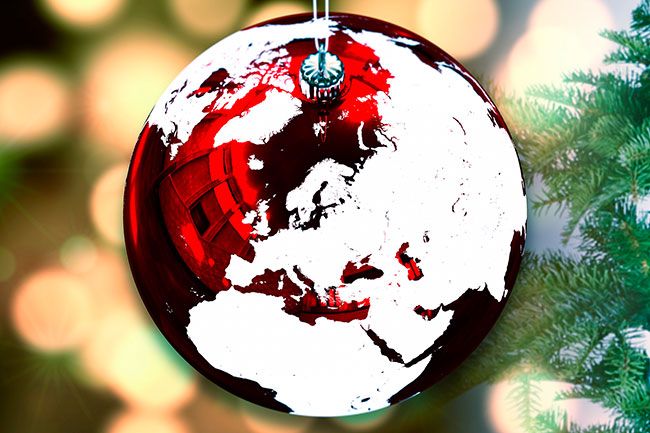Starla Pointer: Relishing the global magic of Christmas
The magic of Christmas brings us together to share our traditions. We share them within our families, faith communities and wider community.
For most, it’s a Christian holiday honoring Christ’s birth.
Some contend Jesus was not born in December. Whether they interpret the Dec. 25 date literally or not, however, they find joy in the promise represented by that day.
For many, it’s time for a decorated tree. That means glowing lights — a perfect counterpoint to the dark days of winter — accompanied by traditional music and special foods.
For many, it’s a time to get together with family and exchange gifts — whether the presents are toys for children or sweet sentiments of appreciation. Some cultures exchange gifts on different days, such as St. Nicholas’ Day, which falls on Dec. 6, or the Epiphany, on Jan. 6.
Growing up in Puerto Rico, Zorayda “Zora” Santiago Lam of Newberg looked forward to exchanging presents on Three Kings’ Day, another name for Jan. 6.
When I interviewed her in 2014 for my annual “Holiday Traditions” series, featuring the customs of people coming here from other countries, she told me her friends even wrote letters to their favorite Wise Man — Melchior, Gaspar or Balthasar — asking for toys, dolls or jewelry.
Young Zora, hedging her bets, wrote all three. And she made sure to fill a shoebox with straw and place it beside her bed as Jan. 6 approached, so the Kings’ camels could have a snack.
Some countries in which Christians are in the minority celebrate Christmas anyway. In Japan, for instance, Shintos and Buddhists enjoy a happy holiday with Western-style meals, festive table-top trees and Christmas cake.
Japanese native Ai Mitsunaga, whom I interviewed while she was spending a year teaching at the McMinnville Adventist Christian School, said Christmas wreaths and lights are as popular back home as they are here. In Kobe, she said, thousands of sightseers flock to see white lights arching over the main streets in the business district.
Private homes are illuminated as well. “I love to see the lights,” she said.
Not many countries go all out like Japan and the U.S., but people around the world put up lights — if nothing else, illuminated wreaths or candles in a window. Lights are popular even in countries below the Equator, where Christmas coincides with the long days of summer.
Lorraine Jones of Amity admired commercial light displays after spending the day at the beach in her hometown of Sydney, Australia.
In 2014, Jones told me Australia celebrated holidays much like the U.S. — and like England, as Australia was once a British colony. But the hot weather, singing magpies, kookaburra birds, tropical flowers and ripe fruit made festivities “Down Under” unique.
No outdoor Christmas lights were allowed when Jean Penn of McMinnville was a girl in rural England. World War II was raging, with a blackout strictly enforced, she told me in 2003.
Indoors, though, her family celebrated with real candles decorating the Christmas tree. Some years, children who had been evacuated from bomb-torn London joined them for the holidays.
Although sugar and other foods were rationed, Jean’s mother managed to steam plum puddings for dinner on Christmas, Boxing and New Year’s days.
The traditional dessert is a dense, dark fruitcake studded with raisins and filled withcandied fruit. Laced with liquor, it keeps forever, Penn said.
In some other places, at various times, Christmas itself has been banned.
In the 1960s, when Angel Aguiar of Dayton was a boy growing up in Cuba, religious celebrations were outlawed by Fidel Castro.
Children were taught that Castro, not God, was the source of all good things, he told me earlier this year.
But little Angel refused to believe that. In fact, his teacher sent him to the principal’s office because he refused to listen to the Communist message.
Linfield voice professor Anton Belov, whom I interviewed in 2012, grew up under Communist rule in Moscow. In December, his family brought home a tree and decorated it with shiny colored balls anyway.
There were presents, to the extent gifts could be obtained in a land of such austerity. And Anton, like other children, looked forward to the arrival of a bearded man in a velvety red robe trimmed with fur.
But the Russians weren’t celebrating Christmas.
Like other religious holidays — and religion itself, for that matter — it was banned. Both Dec. 25 and Jan. 7, marking the traditional Eastern Orthodox Christmas, were simply regular work days in the Soviet Union.
So the people did what they had to. They maintained their Christmas traditions by moving them to New Year’s Day, an official, government-sanctioned holiday.
“We had a New Year’s tree and we waited for Grandpa New Year,” Belov said.
Russians occupied Magdeburg, in northeast Germany, when Monika Lautenbach was a girl. Borders were closely controlled, and Monika and other schoolchildren were required to learn Russian.
After a few years, her family decided to escape. On a late-Autumn night, she fled with her parents, her older brother and her dachshund, Waldy. They crossed farmland to reach the Elbe River, then forded the river into West Germany, taking only what they could carry.
She spent the rest of her youth in Braunschweig, then pursued university studies in GÖttingen and Hamburg.
In Hamburg, she met American medical student John Lautenbach. After marrying, they moved to the U.S. They settled in McMinnville in 1974.
Lautenbach taught German at McMinnville High School for 13 years.
She and her husband still observe many German traditions at Christmastime. She decorates with fragile straw snowflakes and stars, like she make as a child, along with a German cloth, Advent candles, greenery and other items.
But they put up their tree in early December, rather than waiting until Christmas Eve, as she did back home.
These are just a few of the people I’ve interviewed about how they celebrated before moving to Yamhill County.
I’ve been fortunate over the last 18 years to have interviewed about 100 local people who’ve come to Yamhill County from other countries. Some arrived here as children, others as young adults, a few later in life.
I found them by keeping my ears open for accents, by asking co-workers and friends for recommendations, and by visiting their businesses.
Last year, I interviewed Ignacio Veles, owner of Noah’s Bakery. He told me about growing up in Michoacan, Mexico, and becoming a baker’s helper there.
You’ll never guess how I found him!
As Veles was telling me about opening his own business in McMinnville, he received a phone call from one of his suppliers. I waited — not evesdropping! — as he added guava paste and coconut to his usual order, then said, “And throw in a bag of babies.”
A bag of babies?!!! I couldn’t help but ask about that. He told me the tiny plastic babies were for the Kings’ Day cakes he bakes in early January.
Each of the round Rosca de Reyes cakes — literal translation, “Ring of Kings” — features a baby hidden in the batter. As they celebrate the arrival of the Wise Men bringing gifts to Baby Jesus, people search for the baby — a symbol of good fortune.
Hence the bakery’s need for “a bag of babies.”
Veles and others have described Christmas and Kings’ Day, Santa Lucia and St. Nickolaus, Hoggamany and Divali, Christmas pickles and candy chains, Christmas cake and plum pudding, and stockings filled with nuts and oranges.
They’ve also related their personal stories, as this series is about the people, after all, not just the holidays.
The series has enriched me, just as these people have enriched our community.
This is a melting pot of cultures and traditions. Talking about and sharing our differences reminds us how much we have in common, as well as how unique we all are.











Comments